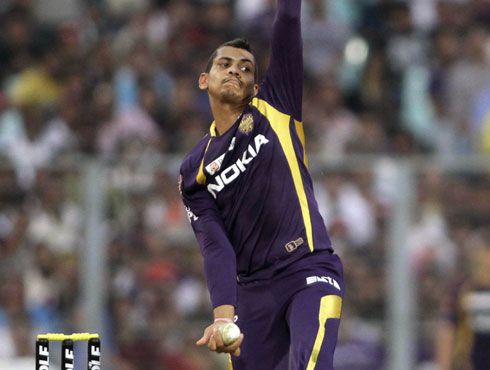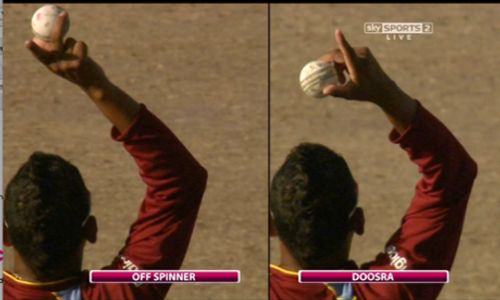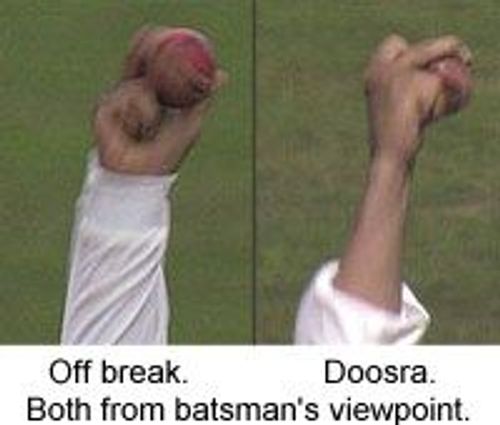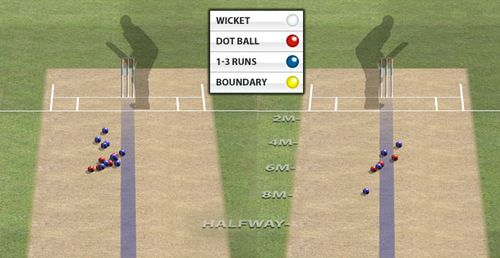
Understanding the Sunil Narine mystery

Disclaimer: This article simply tries to point out why Sunil Narine is so good in limited overs cricket, especially in death overs. If I had known how to decipher him, I’d have played 100 ODIs and 50 Test Matches for India by now.
Having cleared that out, let’s proceed. It all started on 2 October 2011. I was watching Chennai v Trinidad and Tobago, a Champions League T20 fixture. With T and T restricted to 123, I watched in horror as MS Dhoni, one of the best limited overs batsmen in modern day cricket, struggled to lay bat on ball against an unheralded West Indian with a mohawk. In all, Dhoni scored 7 runs off 22 balls in the match, and his struggles were finally ended by that skinny little West Indian, who eventually had figures of 3 for 8 in 4 overs.
“Ah, an aberration,” I thought to myself. This guy bowls too short for a spinner. Though not short, but short of a length. One simply has to rock back, shift the weight to the back foot and pull.
What followed really needs no mention. My theory at first glance was as wrong as it could possibly be. Today, in all humility, unlike my brash first impression, I try to explain why he is such a menace in limited overs cricket against batsmen all over the world.
Q1) What does Narine do?
As an off-spinner, you generally have the stock delivery, the arm ball and the faster one. If you are good, you have the doosra, as well. Meet Sunil Narine. Apart from these, he bowls the carrom ball, the top spinner, the leg-spinner and the leg-spinning googly (Yes, I’ve actually seen him bowl that).
So, if you put things in perspective, there are 6 deliveries in an over, and he has 8 variations. In short, there are 262144 ways in which he can bowl the 6 balls in his over: a figure approved by noted cricket writer Abhishek Mukherjee. Sherlock will be bamboozled with that number, let alone the batsmen who have failed to decipher him.
With so many variations, it is almost impossible to pick which one he’s going to bowl. Though he has shown a few trends over the years, the problem is, even after that, it is impossible to get him away despite knowing what is coming at you. More on that later, but what is worth a mention is that almost 90% of the balls he bowls in the death overs are the ones spinning away from the batsmen. Pretty easy, one might think then. But the nightmare for a batsman is that he has three ways of doing so.
If a right-hander is on strike, he will bowl either the doosra or the leg-spinner and will come up with the stock delivery or googly to the lefties. He also floats in some top spinners and carrom balls in between these to maintain his mystery. Since the grips are so similar, it’s almost impossible to pick the one he’s going to bowl. For those who don’t know, the carrom ball is bowled by flicking the ball between the thumb and bent middle finger. Narine can spin the carrom ball both ways, too. And, finally when you begin to feel he’s turning them all away, he slips in the top spinner, a delivery that has been imparted with forward spinning revolutions; as a result, the ball not only falls faster and earlier than what one might expect but also bounces like a beach ball. Things just don’t get easier, do they?
The very recent super over maiden demonstrates Narine’s prowess. He constantly spun them away from both the left and right handers, as can be seen here
Q2) Why is Narine different from other bowlers?
Apart from the obvious fact that he has almost double the number of variations, three things in which Narine really stands out are gripping the ball, fast spinners and subtle variations. Let us compare Narine’s grip with a normal bowler’s grip:


Let us talk about his grip first. If you look the picture above, he almost spins the ball without help from his index finger. He does it with the thumb and the middle finger, which is one of the most unconventional ways of spinning the ball. No other spinner in international cricket has this kind of grip, not even Ajanta Mendis.
If you look at the other picture, which is from the batsman’s viewpoint, you can see a distinct difference between the two grips. This is because those deliveries are imparted spin from the index finger, the conventional method of spinning the ball.
Because of this, his variations are almost impossible to pick from the hand.

Next up, let us discuss his length and speed of the ball. Generally, spin bowlers bowl flighted deliveries; if they’re being hit out of the park, they resort to faster ones. However, in both cases, they pitch it nearer the 4m mark rather than the 6m mark.
Narine, however, hardly flights the ball as much. He rushes the balls through the air and generally pitches it slightly back of a length, more towards the 6M mark. The pitching is so clever that the batsman can neither use his feet to get to the pitch of the ball nor can he rock back and pull or cut with disdain. There are obviously the occasional full balls or short-pitched deliveries, but he manages to stay very consistent with them.
The third and most important difference between Narine and other bowlers is the subtle variations he possesses, rather than always spinning the ball a long way. How and why this is effective is covered in the next section of the article.
Q3) Why is the Trinidadian effective?
In the death overs, the batsmen are usually looking to score quick runs. The two areas that are generally targeted are the square leg region and the V from mid-wicket to long-off. As I stated earlier, Narine turns the ball away from the batsmen. Hence, it is very difficult to hit these balls towards the generally targeted areas.
A simple analogy to understand this is a spinning top. Once you spin a top, it is easiest to touch it lightly, easier to stroke it in the direction of the spin, difficult to make it stop, and almost impossible to make it spin in the opposite direction.
The spinning ball is the same. Though the spin may not be visible to the naked eye, there are a number of revolutions imparted to the ball, to the tune of 1800-2400 rpm (rotations per minute). This means if the ball keeps spinning for a minute, it will spin around 2000 times. The ball generally deviates when the seam of the spinning ball hits the pitch square on; even if it doesn’t, the revolutions are still pretty high.
Coming to the analogy, it is easiest to defend the ball, easier to hit it with the turn, difficult to milk it against the spin, and very, very difficult to dispatch it against the spin. It requires a tremendous amount of power and a certain level of luck, as well.
Now, one may feel that since the ball is almost always turning away, why wouldn’t the batsman be able to hit with the turn. There are three aspects to this question: One, he does not flight the ball, so they come pretty quickly at you; Two, he does not pitch them near the batsman, either, so they cannot convert it into a half volley and hit them inside out; And, finally, all three of his away spinners behave differently.
The first and second aspects are inter-related. The fast-spinners and short of a length bowling mean you can never get underneath the ball and loft it, unless he errs in length. It also means using your feet to get to the pitch of the ball: a futile exercise.
The leg-spinner and leg-spinning googly have more flight than the other deliveries and tend to deviate a lot more, the carrom balls are generally fast subtle spinners, and the stock ball and doosra are sandwiched between the two. And he not only hides his grip but also uncannily changes it in the last moment to leave the batsmen clueless even if they know they are facing the prospect of playing an away-spinning delivery. He slips in other deliveries time and again, as well, most often the top spinner, which has to be played in the exact opposite manner as the away-spinning ball. The full sleeves do no harm to his mystery bowler reputation either.
Enough with theory, then. Let us analyze his performance against SRH in a CLT20 match in 2013.
Watch Sunil Narine spin a web around the SRH batting line-up here.
This video is a very good example of what Narine does best: spin the ball away more often than not and still not be predictable. The first wicket of Parthiv Patel was a normal off spinner. Yes, every right-arm off spinner will spin the ball away from the batsman. However, coming to the next wicket of Hanuma Vihari, it reiterates two facts: he spins them away from the right handers, as well, and you simply cannot leave your crease.
Darren Sammy, his West Indian counterpart, was clearly setting himself up to play the away-spinning delivery, but he was cut in half when Narine bought it into him, showing how unpredictable he can be when the situation demands. The next ball was back to normal ways as he spun the ball away from the right-handed Asish Reddy, who tried to play against the turn in vain.
Finally, another aspect which makes him so successful in LOIs, and apparently not-so-successful in Tests, is the fact that he uses subtle variations to deceive the batsmen. The problem with balls that deviate a lot more than what the batsman is expecting is that they will generally beat him, and all ends up. Either that or it gives the batsman time to readjust and play the ball differently. What Narine does is that he deviates the ball, say, 5 centimetres on both sides. Owing to this, the batsmen generally either go through the shot or fail to readjust, almost invariably leading to a wicket rather than merely a dot ball.
This is perhaps why he is not-so-successful in Tests. Since the batsmen are looking to survive, they play him out, watching the ball closely till the last minute, exactly opposite of what happens when you’re looking to hit the ball out of the park.
So, that ends why and how I feel Sunil Narine is such a force to reckon with in LOIs. If you feel that he has another weapon in his arsenal not mentioned here, or any other idea of countering him, do leave your thoughts in the comment section below.